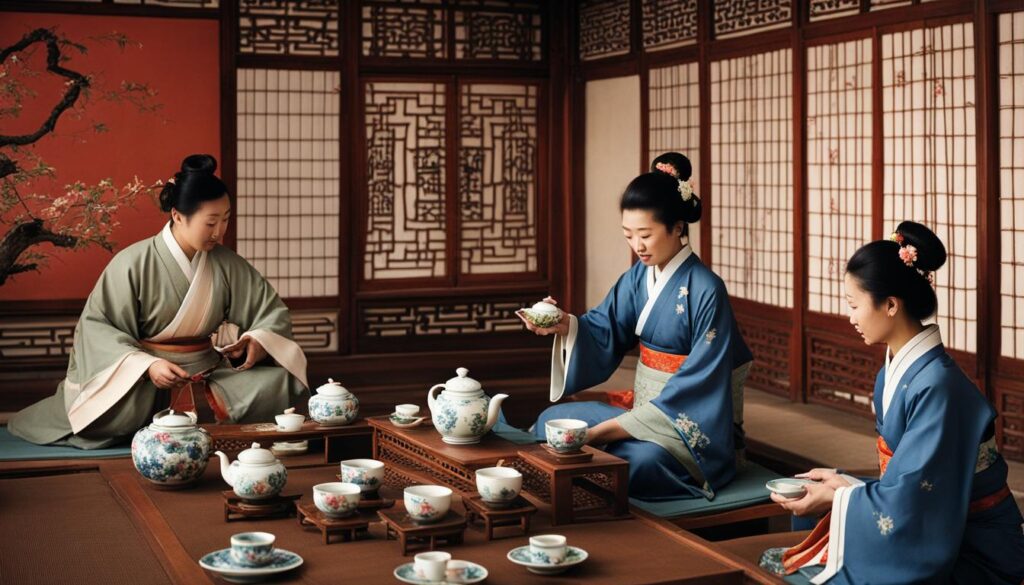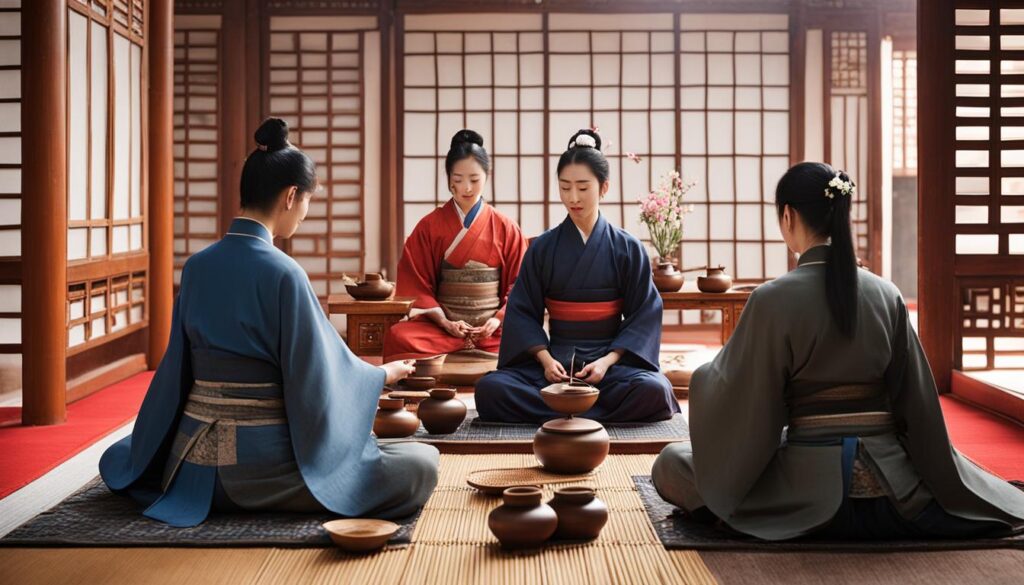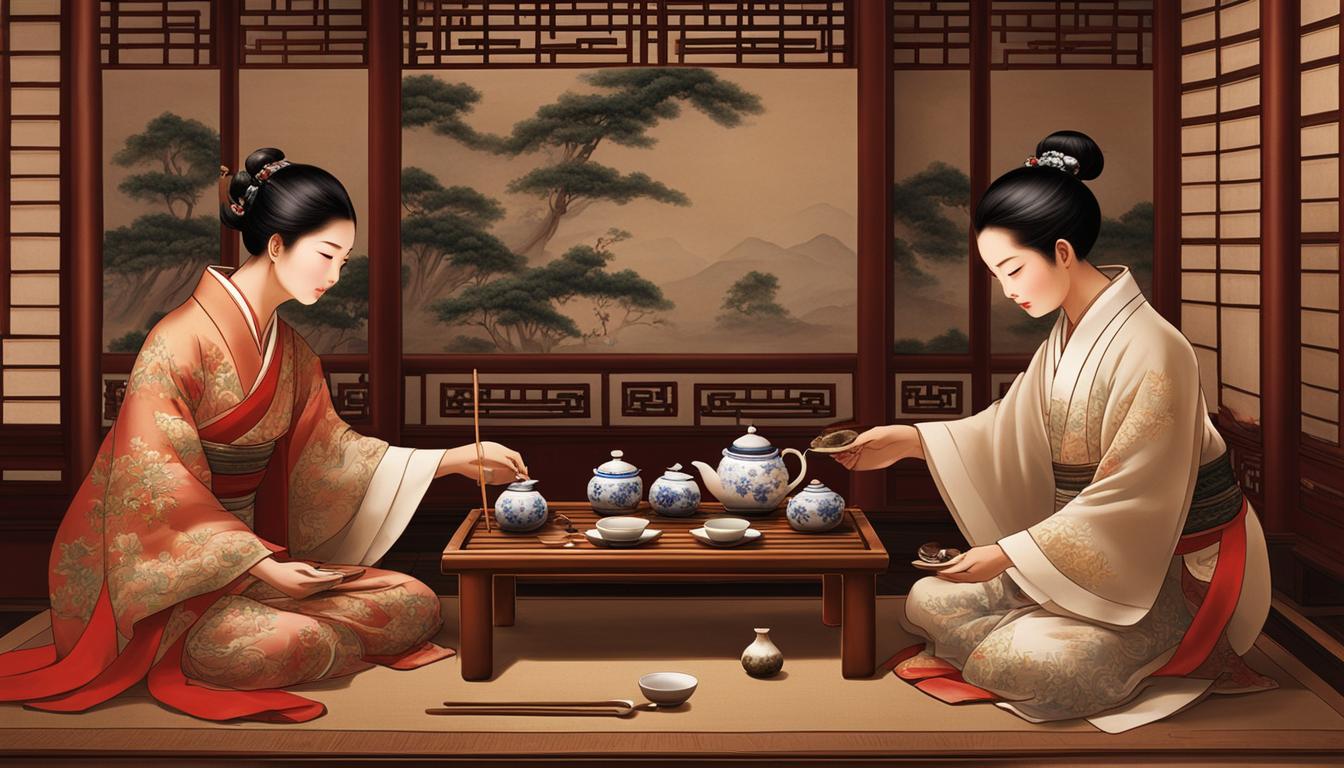Welcome to our exploration of the fascinating world of Chinese tea ceremonies, where every sip carries hidden meanings and cultural significance. In this article, we will delve into the symbolism of Chinese tea ceremonies, deciphering the colors, flowers, and intricate patterns that hold profound significance. Join us on this enchanting journey as we unravel the mysteries behind this ancient practice.
Key Takeaways:
- Symbolism in Chinese tea ceremonies offers deeper insights into the cultural traditions and beliefs.
- Colors in Chinese tea ceremonies hold specific meanings, representing emotions, elements, and energies.
- Flowers used in Chinese tea ceremonies convey messages and symbolize various virtues and wishes.
- Understanding the symbolism enhances our appreciation of the beauty and intention behind each gesture and object in the ceremony.
- Exploring the symbolism in Chinese tea ceremonies enhances our cultural understanding and connection with others.
The Ritual of Chinese Tea Ceremony
The Chinese Tea Ceremony is a mesmerizing and ritualistic practice that encompasses specific gestures, elements, and symbolic objects. This ancient tradition involves brewing an enchanting elixir using loose-leaf tea or coffee infused with intention and energy. As the tea is poured, it forms exquisite patterns and symbols in the cup, each carrying profound meaning.
The practitioner then engages in a meditative act of sipping the tea, focusing their thoughts and energies on a particular question or aspect of life. The symbolic symbols and shapes that appear in the tea leaves are carefully decoded and interpreted, revealing insightful guidance and inspiration. This ancient divination practice allows individuals to gain clarity and illumination through the wisdom of the tea leaves.
The Chinese Tea Ceremony is not merely a beverage-drinking ritual; it is a transformative experience that connects the practitioner with the essence of life itself. By engaging in this meaningful practice, participants can cultivate mindfulness, tranquility, and a deeper appreciation for the beauty of nature and the art of tea brewing. It is a reminder to slow down, be present in the moment, and find serenity in the simple act of sharing tea.
| Symbolic Objects | Gestures Significance | Elements Interpretation |
|---|---|---|
| Tea Utensils | The selection and use of specific tea utensils hold symbolic meaning. For example, the teapot symbolizes abundance and nourishment, while the tea cups represent hospitality and connection. | The elements used to brew the tea, such as fire, water, earth, and air, represent the interconnectedness of nature and the harmony of the universe. Each element contributes to the overall balance and flavor of the tea. |
| Flowers and Plants | The presence of flowers and plants in the tea ceremony reflects the beauty and fragility of life. Each flower or plant carries its own symbolism, representing ideas such as love, purity, and renewal. | The flowers and plants used in the ceremony can also evoke specific emotions or qualities. For example, chrysanthemums symbolize longevity and resilience, while orchids represent elegance and refinement. |
| Tea Leaves | The tea leaves themselves hold significant symbolism. The shape, color, and texture of the leaves can convey messages and insights. | For example, curled tea leaves may indicate a journey or transformation, while vibrant green leaves may symbolize growth and abundance. Each characteristic of the tea leaves adds depth and meaning to the overall tea ceremony experience. |
Through the artful arrangement of symbolic objects, the intentional gestures performed during the ceremony, and the interpretation of elements, the Chinese Tea Ceremony becomes a profound spiritual practice. It invites participants to embark on a journey of self-discovery, introspection, and connection with the divine energy that flows through all things. The tea ceremony serves as a reminder to embrace the present moment, find harmony within ourselves and the world, and appreciate the beauty and symbolism that surround us.
Symbolic Meanings in Chinese Tea Ceremony
The Chinese Tea Ceremony is an ancient practice that is steeped in symbolism and filled with meaningful rituals. One of the key concepts explored in the ceremony is the Yin Yang balance. Yin and Yang represent opposing forces in the universe, with Yin symbolizing femininity, darkness, and the moon, while Yang represents masculinity, light, and the sun. This concept is evident in the tea ceremony, where the balance between these two forces is sought to create harmony and unity.
The Gongfu Tea Ceremony, a traditional Chinese tea brewing method, also holds symbolic meanings. The precise and deliberate movements involved in the ceremony reflect grace, harmony, and the interconnectedness of all things. Every gesture and action during the ceremony is performed with intention and mindfulness, emphasizing the importance of being fully present in the moment. Each element of the tea ceremony, from the tea utensils to the tea sets used, carries its own symbolic significance, representing cultural values and beliefs.
The Yin Yang Concept
In Chinese philosophy, the Yin Yang concept represents the duality and interconnectedness of all things. It is the belief that opposites are complementary forces that exist in harmony. The Yin Yang symbol, often depicted as a circle divided into two halves, with black representing Yin and white representing Yang, illustrates this balance. In the tea ceremony, the Yin Yang concept is embodied through the balance between the flavors, aromas, and temperatures of the tea. It is believed that this balance creates a harmonious experience that nurtures both the body and the spirit.
| Symbol | Meaning |
|---|---|
| Lotus Flower | Purity and enlightenment |
| Dragon | Power and strength |
| Crane | Longevity and wisdom |
| Peony | Prosperity and honor |
“The Chinese Tea Ceremony is an intricate practice that embodies the essence of Chinese culture and philosophy. It is a way to connect with nature, the self, and others while seeking balance and harmony in every sip of tea.” – Tea Master Li Ming
By understanding the symbolic meanings in the Chinese Tea Ceremony, we can gain a deeper appreciation for the cultural richness and philosophy behind this ancient practice. It allows us to connect with the wisdom of our ancestors and find moments of peace and tranquility in our modern lives. The symbolism in the tea ceremony serves as a reminder to slow down, be present, and savor the simple pleasures that life has to offer.

Chinese Tea Ceremony Symbolism in Art
Art has always been a powerful medium for expressing cultural beliefs and traditions. The Chinese Tea Ceremony, with its rich symbolism and deep cultural significance, has inspired artists to incorporate its elements into various forms of art. From paintings to ceramics, these artworks aim to capture the essence of the ceremony and convey its profound teachings.
One of the recurring themes in art inspired by the Chinese Tea Ceremony is the concept of harmony and balance. Artists use symbolism to represent the interconnectedness of all things, drawing inspiration from the ceremony’s emphasis on finding equilibrium. The Yin Yang symbol, representing the balance of opposites, often appears in these artworks, reminding viewers of the need for harmony in their own lives.
Artists use symbolism to enhance the visual experience and evoke emotions related to the ceremony’s themes of harmony, balance, and spiritual connection.
Flowers are also a common motif in art inspired by the Chinese Tea Ceremony. Each flower holds its own symbolic meaning, conveying messages of love, beauty, and good fortune. Artists carefully select flowers to represent different emotions and ideas, creating a visual narrative that complements the ceremony’s spiritual nature.
To showcase the impact of the Chinese Tea Ceremony symbolism in art, let’s explore a table that highlights some notable artworks:
| Artwork | Artist | Symbolism |
|---|---|---|
| Zhang Xiaogang | The artwork depicts a tea ceremony scene with intricately designed tea sets. The symbolism lies in the delicate balance represented by the arrangement of the tea cups and the serene expressions on the participants’ faces. | |
| Li Huayi | This painting showcases the beauty of nature in the form of lush mountains and flowing rivers. The artist captures the spirit of the Chinese Tea Ceremony through the harmonious blend of natural elements and the presence of a tea set amidst the scenery. | |
| Zeng Fanzhi | In this artwork, the artist incorporates the Yin Yang symbol alongside blooming lotus flowers. The symbolism emphasizes the balance of opposing forces and the purity of the lotus, reflecting the philosophy of the Chinese Tea Ceremony. |
These artworks serve as a visual representation of the Chinese Tea Ceremony’s symbolism, allowing viewers to further connect with its profound teachings. Through the use of symbolism, artists convey the ceremony’s messages of harmony, balance, and spiritual connection, inviting viewers to immerse themselves in the beauty and meaning of the Chinese Tea Ceremony.
The Meaningful Practices of Chinese Tea Ceremony
Participating in the Chinese Tea Ceremony involves more than just drinking tea; it is a deeply meaningful practice that offers numerous benefits for the body, mind, and spirit. The ceremony encourages mindfulness and intentional presence in the present moment, fostering a sense of tranquility and reflection.
One of the key aspects of the Chinese Tea Ceremony is its focus on connection. By partaking in the ritual, participants are reminded of the importance of connecting with oneself, others, and the natural world. It serves as a reminder to slow down and appreciate the beauty of nature, the art of tea brewing, and the significance of interpersonal relationships.
The Chinese Tea Ceremony also provides an opportunity for self-discovery and personal growth. Through the rituals and symbolism of the ceremony, individuals can gain a deeper understanding of themselves and their place in the world. It offers a space for contemplation, self-reflection, and the exploration of one’s own thoughts and emotions.
The Benefits of the Chinese Tea Ceremony
- Enhances mindfulness and promotes a sense of tranquility
- Fosters a deeper connection with oneself and others
- Promotes reflection and self-discovery
- Encourages appreciation for nature and the art of tea brewing
- Nurtures interpersonal relationships
- Offers a space for contemplation and self-reflection
“The Chinese Tea Ceremony is not just about tea; it’s an invitation to slow down, be present, and connect with ourselves and those around us.”
The Chinese Tea Ceremony is a practice that nourishes not only the body but also the mind and spirit. It invites individuals to embark on a journey of self-discovery and enlightenment, offering a deeper appreciation for the cultural and spiritual aspects of tea. So, the next time you enjoy a cup of tea, consider embracing the meaningful practices of the Chinese Tea Ceremony to enhance your tea-drinking experience.

Conclusion
The Chinese Tea Ceremony is a fascinating cultural practice that encapsulates the richness of symbolism. From the intricate patterns and symbols formed by tea leaves to the deliberate movements and meaningful practices, every aspect of the ceremony holds deep significance.
The Gongfu Tea Ceremony, in particular, is a treasure trove of symbolic meanings. The concept of Yin Yang, representing the balance of opposites, harmonizes with the grace and interconnectedness reflected in the ceremony’s precise rituals. The tea utensils and sets used in the ceremony add another layer of symbolism, representing cultural values and beliefs.
By immersing ourselves in the symbolism of the Gongfu Tea Ceremony, we embark on a journey of self-discovery and enlightenment. Through mindfulness and reflection, we can deepen our understanding of ourselves and the world around us. This profound cultural practice encourages us to appreciate nature’s beauty, embrace the art of tea brewing, and foster meaningful connections with others and the larger universe.
So, next time you sip a cup of tea, take a moment to reflect on the symbolic meanings it holds. Let the rituals and symbolism of the Chinese Tea Ceremony guide you towards a greater appreciation for the cultural and spiritual aspects of tea. Cheers to a journey of discovery!
FAQ
What is tasseography?
Tasseography, also known as tea leaf reading, is a form of divination or fortune-telling that involves interpreting patterns and symbols formed by tea leaves or coffee grounds in a cup.
What are the common symbols in tasseography?
Symbols that often appear during a tea leaf reading include animals, objects, shapes, numbers, letters, and signs.
What is the Chinese Tea Ceremony?
The Chinese Tea Ceremony is a ritualistic practice that involves specific gestures, elements, and symbolic objects. It is a mindful and intentional practice that encourages participants to be fully present in the moment.
What is the meaning of Yin Yang in the Chinese Tea Ceremony?
The concept of Yin Yang, representing the balance of opposites, is often explored in the Chinese Tea Ceremony. Yin represents femininity, darkness, and the moon, while Yang symbolizes masculinity, light, and the sun.
How is the Chinese Tea Ceremony depicted in art?
The symbolism of the Chinese Tea Ceremony has been widely depicted in various forms of art such as paintings, calligraphy, ceramics, and sculptures. These artworks capture the essence of the ceremony and convey its deep cultural significance and teachings.
What are the meaningful practices of the Chinese Tea Ceremony?
The Chinese Tea Ceremony promotes connection with oneself, others, and the natural world. It fosters a sense of tranquility, mindfulness, and reflection. Participants can cultivate a deeper appreciation for the beauty of nature, the art of tea brewing, and the importance of interpersonal connections.





